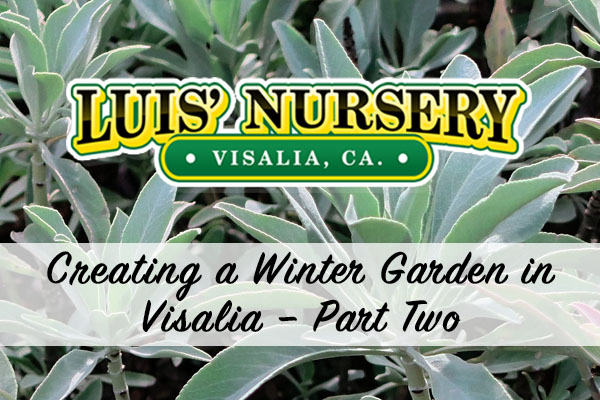Our winter brings life to summer drought adapted plants and the start of root growth. The San Joaquin Valley and Visalia area are known for milder winters that lend themselves to a joyful gardening season year-round. In our last article, we discussed some tips and suggestions on how to create a winter garden in Visalia. Here are a few more plants that you can add to your garden to create the ‘winter wonderland’ of your dreams, without the blanket of white snow.
As you’ve started to add to your winter gardens, you may have added winter blooms such as Manzanitas that come into their glory with attractive urn-shaped flower clusters. One example of a manzanita that performs well is the Vine Hill Manzanita. It offers clean, dark-green foliage and pale pink flowers. Or maybe you added some beautiful California currants that help supply much needed nectar to passing hummingbirds or create shiny majestic mounds of foliage. What else can you add to your winter gardens?
You can add some drama to your garden by incorporating silver foliage and accent plants. These help to keep your garden interesting during the rainy winter months.
Some examples are:
- Native white sage – Silver leaves that shine in winter, it only needs pinching when young to induce branching to create the shrub-like form.
- Cenizo – Although it’s not native it maintains a lovely silky gray foliage throughout the winter and rewards you come summer and fall with lavender pink flowers.
- Coral Yucca – Tough and adaptable it produces showy flowers in the summer and in the winter its narrow, evergreen leaves form a spiky corona.
How to maintain your winter garden
Now that you’ve created your beautiful winter garden, how do you maintain it during our central California winter? Central Valley gardens are often plagued with heavy clay soil. One way to protect this soil from becoming too compacted is by placing a thick layer of mulch before winter rains. When applying mulch, be sure to leave a space between the mulch and the plant’s trunk to avoid trapping moisture at the stem that will cause damaging fungal diseases. Another benefit of mulch is it suppresses weed germination which reduce the need for herbicides and allows you to play in the wet soil safely all winter. This same mulch will help you to keep your roots cooler and reduce water loss, great for us during drought season, come summer.
Some other important steps to take are:
- Remove any water basins – If you’ve taken the time to set up any watering basins around new transplants you will want to remove them in order to avoid standing water.
- Pruning Don’ts – Don’t prune native trees and shrubs in wet weather as this will make them susceptible to fungal diseases at their cut sites. Wait on pruning any frost damaged foliage. You don’t want them left vulnerable to low temperatures
- Pruning Do’s – Cut back fall perennials in winter after the birds have fed on the seeds. This will ensure vigorous growth and tidy forms.
- Leave dead growth after a freeze – Don’t remove any dead growth from the ground after a freeze. This growth will protect the plant from further freezing. Once the danger of frost has passed you can remove spongy and brown growth and reshape plants as needed
By providing proper maintenance and care you can have a garden that will shine gloriously through all the otherwise dreary summer months. Winter is also a beautiful time in the Central Valley to spend time in the garden on some of your more labor-intensive projects without the heat of summer. We are happy to help you with all your landscaping needs and look forward to your next visit here at the nursery.

